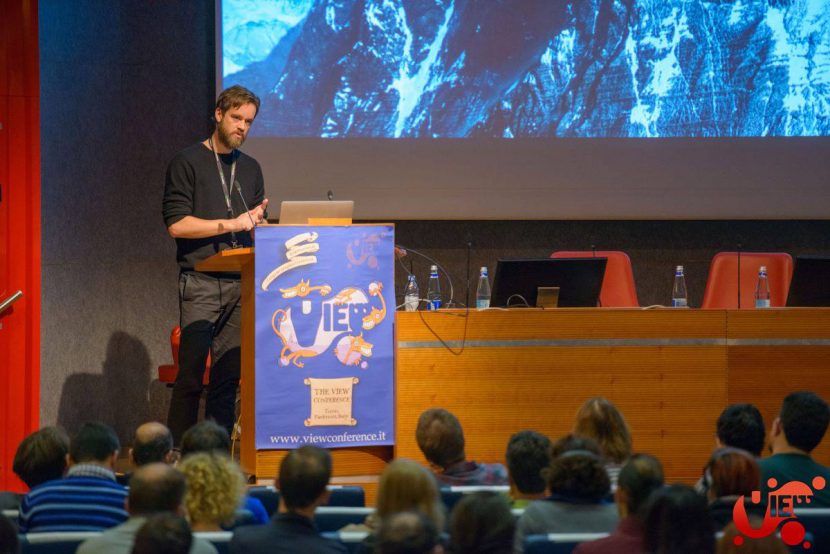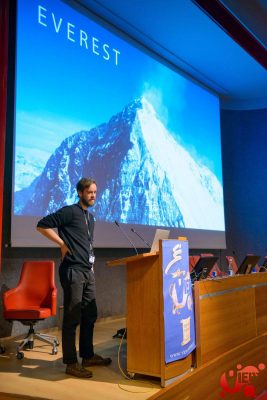Dadi Einarsson is the co-founder and creative director at RVX, a boutique visual effects house he started in Iceland in 2008. You might be surprised to hear that Iceland has a rich history in computer graphics, gaming and visual effects – and Einarsson was involved in the industry’s infancy in Iceland from the early 90s, before heading over to London to work at The Mill and then Framestore (at one point commuting from Iceland to London for The Golden Compass), and later returning to his home country to start RVX. The visual effects supervisor recently worked on the challenging Everest, co-ordinating the efforts of both RVX and several vendors in London and Stockholm. fxguide caught up with Einarsson while we were at the VIEW Conference in Italy.
fxg: Tell me about your experience flying from Iceland to London to work at Framestore each week for The Golden Compass?
Einarsson: I’d been living in New York in four years, and Framestore had a big project coming up, The Golden Compass, and they really wanted me to supervise the animation. At that point, rather than move the family back to London, we figured we’d move back to Iceland now or there wasn’t going to be an opportunity to do that later. So I commuted from Reykjavik to London – I flew out every Monday morning and back home on Friday night for just under two years. I was the animation supe on Golden Compass and overseen the film visual effects animation department.

fxg: What was that like week to week?
Einarsson: I wouldn’t make it into the office until just before noon on the Monday – Framestore were very accommodating with that. I’d go straight into dailies. I’d be up at the crack of dawn tip toeing out trying not to wake the baby. It was a pretty intense work-week. I’d have to run out on Friday between 5 and 6pm and get home at 1am. Then had family time on the weekend. It worked, but after that I wouldn’t necessarily do it again.
fxg: Do you think a remote working situation would have worked?
Einarsson: I don’t think it would have for that particular project. On Everest, I certainly supervised it out of Iceland. I had my lead core team in Iceland which did just over half the show, but then we passed the work out with Framestore, Union, One of Us in London and Important Looking Pirates in Stockholm. You could say I supervised a team doing 100 shots in Stockholm and I never went to Stockholm – we teleconferenced. But on Golden Compass it was more of a team-building thing, understanding the brief, working with the visual effects supervisor and the director. We had to nurture new crew on the team. It was much more ‘on the ground’ work. I also blocked out a lot of stuff myself and got hands on with the shots.
fxg: What happened after Golden Compass?
Einarsson: I had a discussion with Framestore and stayed back in Iceland. They kept me on retainer for a while until we decided to open a Framestore in Iceland. It was July 2008.
fxg: Were there any government subsidies or incentives for Iceland at the time?
Einarsson: Not really. There is a 20 per cent tax rebate and we qualified for that. It’s not like what is available in Montreal or elsewhere. And then October 2008 is when everything just exploded and Iceland really had all of its economic problems. We still worked on lots of films, though. We worked on Australia. I put together an animation team to work on the cattle stampede sequence. We quickly went up to 15 or 20 people, we set up an office right in the middle of town and set up a pipeline, which wasn’t necessarily straightforward. Then the crash happened.
The flip side was that our currency was devalued, which made our labor half-price. So overnight we basically became much cheaper to send work to. So it wasn’t disastrous for us at all, really. We had the problems of living in that environment and all the negative press about Iceland – that was the downside. But we were relatively cost effective.

fxg: At what point did filmmakers and studios start really coming to Iceland to shoot?
Einarsson: It was about 2010 I think when there was Prometheus, Noah, Game of Thrones, Walter Mitty, Oblivion – a quick succession over the space of maybe two summers. The currency devaluation was definitely a part of that and the tax incentives was a very quick system. Plus we’re lucky enough to have a very unique landscape, and good crews. They’ve got really can-do attitudes.
fxg: When did you then start out with your own company?
Einarsson: Framestore in Iceland lasted around four years, and then in 2012 I bought them out. I had the opportunity to go independent and so I bought them out. At that point I’d done two films with the director Baltasar Kormákur (Contraband and The Deep), so I could see a steady stream of that sort of project coming from him. His star was rising. He showed a lot of faith in us too. We also shared a vision of offering a turn-key solution in Iceland from start to finish.
fxg: And can you go back to the start of VFX in Iceland, is there a long history of it there?
Einarsson: I guess I was involved in the inception of it in around 1992. We started a company called OZ. It was three guys who started and I joined a year later. Computer graphics were starting to kick off around the world and we tried to get access to the tools and see what could be done.
fxg: This is basically just after films like The Abyss and Terminator 2 but just before Jurassic Park?
Einarsson: Yes, it was all just starting. And obviously a single workstation from Silicon Graphics would set you back $50,000. But because Iceland is a small country, we were able to get distributor status for SGI and Alias at the time. We would be selling the hardware and software to Icelandic TV companies and other customers, but we’d also be building up our own knowledge. I had just finished art school and I would get various animation notes (including from my mother who is an animator) and I’d sit down in front of a machine and work it out. We got some programmers on board and started programming add-ons. We did the first shader library for mental ray for Softimage. It was an environment shader – you’d just set the time of day and it did sunrise, sunset, clouds and everything. Then at that point we started getting Softimage licenses for free and so we could start playing with that and fell in love with that completely.
At the same time we were producing commercials and film shots for local productions in Iceland. Then at that point it was 95/96/97 and the Internet was getting bigger and the company was steering more towards doing virtual worlds. We wrote a VRML browser called Oz Virtual, but we were just too soon. If you look at that and then say Second Life – we were about seven years too early. I peeled away from that, moved to London, started working at The Mill. Pretty soon I was at Framestore.
fxg: So what is the current VFX or CG situation in Iceland?
Einarsson: RVX is definitely the main house. The other places are smaller, although there is a large games company in Reykjavik called CCP which is responsible for Eve Online. OZ was really the embryo for it. Pretty much all of these companies, CCP, RVX and other companies doing games – these tech startups have a common ancestor in OZ.
fxg: What are some of the challenges of training digital artists in Iceland?
Einarsson: Myself, CCP and an animation studio CAOZ got together and went to a local arts school in Iceland to help explain what we needed in terms of artists. It’s a validation – we can then endorse the courses and say, yes we would hire from here. That brings in the students to the courses and we get something out of it too.
fxg: What’s the mix of work that RVX is doing at the moment?
Einarsson: We’re a boutique-sized company and we’re between 25 and 50 people. We’re doing film VFX, commercials, venue projects, VR. I don’t really want to go over that size because it can be the first step to losing that intimate culture. I have fantastic relationships with Framestore and other places, so I’ll be more looking to partner with other people once we get above that size. I think VR is interesting because in a way we haven’t had anything groundbreaking and new for a little while. It’s kind of why we got into visual effects in the early 90s – you know, oh my god, dinosaurs! What did I just see? It’s very difficult to do better than what’s been done before in traditional visual effects other than just doing more.
Find out more about RVX and Dadi’s work at http://rvx.is.

Some really nice mattes and 3D in there!